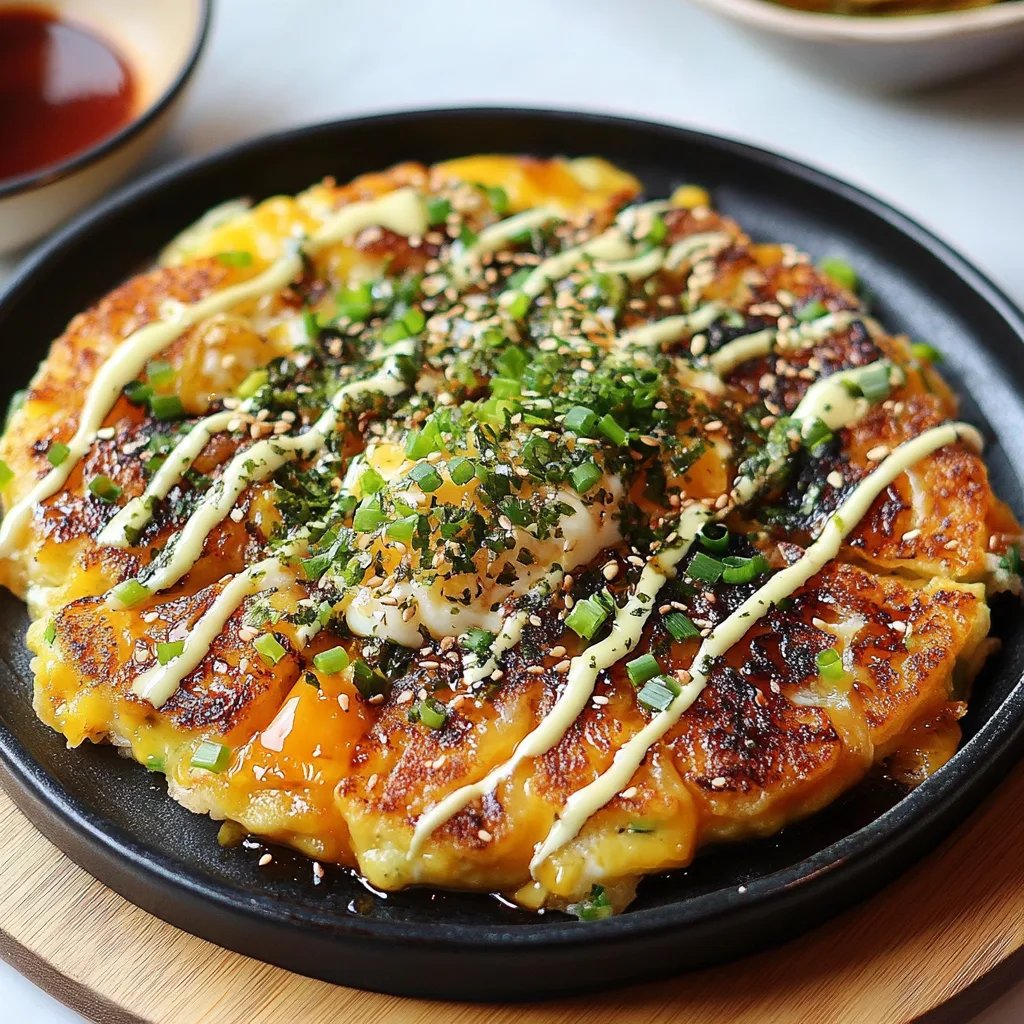Okonomiyaki: An Amazing Ultimate Recipe for 6 Servings

Okonomiyaki is a delightful savory Japanese pancake that enchants anyone who tries it. This dish beautifully blends flavors and textures, offering a unique and heartwarming experience. Traditionally crafted with a variety of ingredients, Okonomiyaki stands out for its versatility, allowing each cook to tailor it to their preferences. From the first bite, you’ll be transported to a street corner in Japan, where the aroma of freshly cooked pancakes wafts through the air.
What makes Okonomiyaki so wonderful is its wealth of ingredients and the culmination of flavors in each bite. Whether you opt for pork, seafood, or go fully vegetarian, each variation has something special to offer. This incredible pancake is not just a meal; it’s an experience that brings people together. In this guide, you’ll discover why this recipe is so beloved, how to prepare it, and tips on serving it perfectly to your family and friends.
Let’s dive into the intricacies of Okonomiyaki and find out how to create this extraordinary dish right in your kitchen!
Why You’ll Love This Recipe
Okonomiyaki is a fantastic dish that offers a plethora of flavors and a delightful texture. Here are some reasons why you’ll fall in love with this amazing pancake:
- Customizable Ingredients – You can create a unique version based on your taste preferences, whether you like meat, seafood, or vegetables.
- Quick Preparation – It takes minimal time to prepare. You’ll have a delicious meal on the table in no time.
- Family-Friendly – Everyone, from kids to adults, can enjoy it. Its savory taste and fun presentation make it appealing to all.
- Perfect for Gatherings – Okonomiyaki serves well at parties, family dinners, or casual get-togethers, making cooking for multiple people easy.
- Nutritious – With the variety of veggies, it’s a healthy choice that can fit into almost any diet, loaded with essential nutrients.
- A Cultural Experience – Making Okonomiyaki allows you to explore Japanese cuisine, bringing a piece of Japan to your dining table.
These factors contribute to Okonomiyaki being a favorite among many. Each bite reveals a symphony of flavors, creating an experience that is not only delicious but also rich in cultural heritage.
Preparation and Cooking Time
Creating Okonomiyaki is a straightforward process that takes about 60 minutes from start to finish. Here’s how the timing breaks down:
- Preparation Time: 20 minutes
- Cooking Time: 30-40 minutes
- Resting Time (Optional): 5-10 minutes
These times may vary slightly based on your kitchen skills and equipment, but this estimate should serve as a helpful guide to planning your meal.
Ingredients
- 2 cups all-purpose flour
- 1 ½ cups dashi stock (or water)
- 1 large egg
- 4 cups finely shredded cabbage
- 1 cup sliced green onions
- 1 cup cooked and chopped meat (pork, shrimp, or chicken)
- ½ cup tempura scraps (tenkasu)
- Vegetable oil (for cooking)
- Okonomiyaki sauce (for drizzling)
- Japanese mayonnaise (for drizzling)
- Aonori (seaweed flakes, for garnish)
- Bonito flakes (for garnish)
Step-by-Step Instructions
Making Okonomiyaki is both fun and rewarding. Follow these steps for an incredible result:
- Prepare the Batter: In a large mixing bowl, combine the flour and dashi stock. Whisk until smooth and free of lumps.
- Add Egg: Crack the egg into the batter and mix it well until fully incorporated.
- Mix in Vegetables: Fold in the shredded cabbage, green onions, and tempura scraps, ensuring everything is evenly coated with the batter.
- Add Protein: Gently mix in your choice of cooked meat, distributing it throughout the batter.
- Heat the Pan: Place a skillet or griddle over medium heat and add a small amount of vegetable oil, allowing it to heat up.
- Cook the Pancake: Pour a portion of the batter into the center of the pan, spreading it gently into a round shape about 1 inch thick.
- Cook Until Firm: Cook for about 4-5 minutes on one side, or until it forms a golden-brown crust.
- Flip the Pancake: Carefully flip the pancake using a spatula and cook for an additional 4-5 minutes on the other side.
- Repeat: Remove the cooked pancake to a plate and repeat the process with the remaining batter.
- Drizzle Sauces: Once all pancakes are cooked, drizzle with Okonomiyaki sauce and Japanese mayonnaise.
- Garnish: Sprinkle with aonori and bonito flakes for added flavor and presentation.
With these steps, you’ll create a beautiful and delicious Okonomiyaki that you and your loved ones will enjoy!
How to Serve
To make the most of your Okonomiyaki experience, consider these serving suggestions:
- Presentation: Cut the pancakes into wedges and arrange on a serving platter. Drizzle additional sauces in decorative patterns for visual appeal.
- Accompaniments: Serve with pickled ginger or a salad on the side for a refreshing contrast.
- Serving Style: Offer Okonomiyaki hot from the skillet. Sharing it among guests as a communal dish enhances the experience.
- Beverage Pairing: Pair with Japanese beer, sake, or green tea to complement the flavors of the dish.
- Toppings: Allow guests to customize their pancakes by adding extra toppings like cheese, kimchi, or chopped herbs.
With these serving ideas, you can ensure that your Okonomiyaki is not only a culinary delight but also a memorable dining experience for everyone!
Additional Tips
- Experiment with Toppings: Don’t hesitate to try different sauces and toppings to enhance the flavor of your Okonomiyaki.
- Use Leftover Ingredients: Okonomiyaki is perfect for using up leftover vegetables or meats. Explore with what you have on hand!
- Adjust Thickness: If you prefer a thicker pancake, add more batter when cooking. A thinner pancake will yield a crispier texture.
- Cook with Care: If using a non-stick pan, reduce the oil amount slightly, but ensure the batter doesn’t stick.
- Keep Pancakes Warm: If making multiple pancakes, keep them warm in an oven set to low heat until it’s time to serve.
Recipe Variation
There are so many ways to spin this classic dish. Here are a few variations to inspire your creativity:
- Seafood Okonomiyaki: Replace the meat with a mix of shrimp, squid, and scallops.
- Vegetarian Delight: Use an array of colorful vegetables, such as bell peppers, mushrooms, and zucchini, to create a hearty veggie pancake.
- Cheesy Okonomiyaki: Mix in shredded cheese, like mozzarella, into the batter for a rich and gooey texture.
- Spicy Kick: Add some chopped chili peppers or a splash of Sriracha to your batter for a spicy version.
- Japanese Curry Flavor: Incorporate curry powder into the batter for a unique and flavorful twist.
Freezing and Storage
Proper storage can help you enjoy your Okonomiyaki later. Here’s how to keep it fresh:
- Storage: Store cooked Okonomiyaki in an airtight container in the refrigerator. They can last for up to 2 days.
- Freezing: For longer storage, freeze the pancakes. Wrap them individually in plastic wrap, then place in a freezer bag. They can last for about 1 month.
- Reheating: To reheat, simply warm on a skillet over low heat until heated through or microwave for a minute or so.
Special Equipment
You don’t need much special equipment to whip up Okonomiyaki, but a few items can make the process smoother:
- Mixing Bowl: A large bowl for mixing your batter and toppings.
- Skillet or Griddle: Ideally, a non-stick skillet or an electric griddle will work best for an even cook.
- Spatula: For flipping your pancakes easily without breaking them apart.
- Whisk: To mix your batter smoothly and incorporate air.
- Measuring Cups and Spoons: Ensure accurate measurement of your ingredients.
Frequently Asked Questions
What makes Okonomiyaki different from regular pancakes?
Okonomiyaki is savory and packed with various ingredients such as cabbage, meat, and seafood, while regular pancakes are typically sweet with syrup.
How can I adjust the texture of Okonomiyaki?
If you prefer a crispier pancake, you can cook it for a bit longer and use less batter. For a softer texture, make it thicker and reduce cooking time.
Can I use gluten-free flour?
Yes! You can substitute all-purpose flour with a gluten-free blend to accommodate dietary restrictions.
Is it necessary to use dashi stock?
While dashi stock enhances the flavor, you can replace it with water if you prefer a milder taste.
Can I make the batter in advance?
Yes, you can prepare the batter ahead of time and store it in the refrigerator for a few hours before cooking.
Conclusion
Making Okonomiyaki at home provides an authentic taste of Japan and a fun cooking experience. With its customizable nature, everyone can enjoy this savory pancake, tailored to their preferences. Gather your loved ones and indulge in this flavorful dish that not only satisfies hunger but also brings joy to shared meals. Whether you stick to the classic recipe or explore exciting variations, Okonomiyaki is sure to become a favorite in your culinary repertoire.
